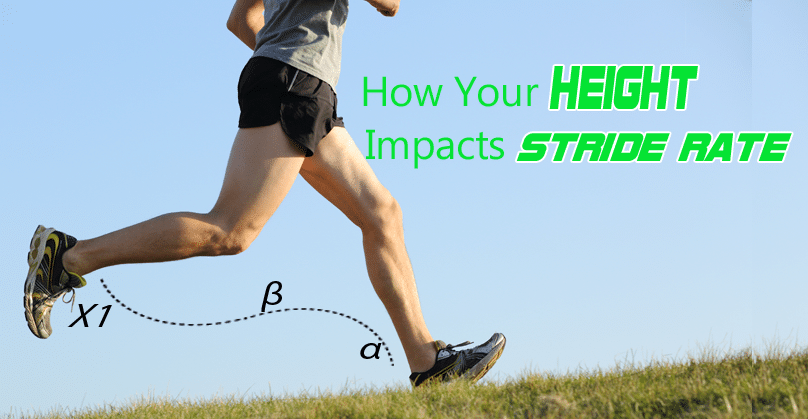If you follow running research, you probably know about all the evidence that says maintaining a high stride frequency (or stride rate or cadence) can reduce stress on your body and prevent injury.
Maybe you have brushed that off, telling yourself, “Well I’m an awfully tall runner, so I just naturally have a low stride frequency”.
Or maybe you are on the shorter side, and you’ve never even bothered to measure your stride frequency because you’re sure it’s high enough.
The underlying assumptions here—that tall runners, who have long legs, take longer strides, and that short runners with short legs take shorter strides—seem like common sense, but not everything in this sport is as simple as it seems.

How your legs are like springs
The question of whether long legs lead to long strides is fundamentally a biomechanical one. The whole reason stride frequency has been studied so intently is that it’s intimately linked with a very basic but extremely useful model of running.
Often, biomechanics researchers model the running stride as a spring bouncing along the ground. This “harmonic oscillator” model sets aside a lot of things you’d think would be very important—like the difference between impact forces and active forces, and the complex interplay of all the joints of the foot, ankle, knee and hip, but despite all this, it’s astoundingly accurate at predicting things like your stride frequency and the energetic cost of running.1
The harmonic oscillator model revolves around one main parameter: the “stiffness” of your leg. Since your entire leg is modeled as a single spring, the stiffness of that spring is the primary determinant of your stride frequency and stride length.
Of course, your leg doesn’t act like a spring all the time. The spring-like behavior is the result of your muscles tensing up right before impact with the ground, and this only occurs for the few tenths of a second that you spend on the ground every step.
To determine the stiffness of a real spring, you’d measure the force produced when you stretch or compress the spring by a certain amount. Biomechanics researchers do the same thing to calculate leg stiffness—they measure the peak forces when you land on the ground while running, then take into account how much your leg length changes while your foot is on the ground.
Once leg stiffness has been determined, all it takes is a little math to predict a runner’s natural or optimal stride frequency.2
As you might imagine, higher leg stiffness leads to a higher stride frequency, just like a weight on a stiffer spring oscillates faster than one on a looser spring.
Leg length differences
Leg length does indeed play a role in calculating a runner’s preferred stride frequency: all else equal, a longer leg should lead to a lower leg stiffness, and thus a lower stride frequency. But the problem is that all else isn’t equal!
A number of other factors, like muscular stiffness, body mass, peak force production, and more, also factor into the equation (literally), and the rest of these are not dependent on leg length.
Based on this, we would expect a population study to show that taller runners, who have longer legs, tend to have a lower stride frequency on average, but that there is still considerable variability in stride frequency among runners of the same height.
Surprising results
Theory is all well and good, but how does this hold up in the real world?
There aren’t any large population studies that measured runners’ preferred stride frequency, but a 1995 paper by three researchers in Boston reported the height, weight, leg length, and natural stride frequency of the ten runners in their study.3
After analyzing the data, I was surprised to find essentially no relationship between leg length and natural stride frequency in the subjects.
The subject with the longest legs in the study had a stride frequency that was only slightly below average, and the highest and lowest stride frequencies (176 and 144 strides per minute) came from subjects with the exact same leg length!
Once I saw this, I conducted my own informal study on the high school runners I coach. While two of my runners with the lowest stride frequencies are indeed quite tall, another two with stride frequencies that were just as low are no taller than five-foot-four!
Plenty of my taller runners also have average to above-average stride frequencies, and there was a huge range of stride frequencies even among runners of equal heights.
Conclusion
All of this evidence indicates that height and leg length are not the sole or even the main determinant of your natural stride frequency. We looked into this in our post comparing your stride frequency to a two year old.
If you’re injury-prone, you shouldn’t use your height as a cop-out to avoid working on increasing your stride frequency.
Short runners aren’t immune to the high impact forces that can result from having a low stride frequency, and it’s not unreasonable or unnatural for a tall runner to adopt a quick cadence to avoid future problems.
How to apply to your running
Step 1: Determine current stride rate
The first step is you want to assess your own cadence to determine (1) if it needs to be adjusted and (2) what your targets should be.
Start by counting the number of times your right leg hits the ground in 30 seconds of running. Then quadruple the number to get your overall cadence. (you quadruple since cadence is a count of both your feet in a minutes time).
This is your stride frequency, often called cadence or stride rate.
Step 3: Set a target
If your cadence is less than 170, you’ll want to try to gradually improve this number. The goal should be something in the 170-190 steps per minute range. There is no magic number, but this is a good range.
Research has shown that you want to try to improve your cadence by no more than 5% at a time. So, if your current stride rate is 160spm, adding the 5% increase, your new target is 168spm.
Step 3: How to improve
Start by adding short distances into your runs in which you try to maintain your new target. This can be done through use of a metronome (available from Amazon or downloadable as an app for your phone).
Be careful as many of these gadgets still regard 180spm as the “magic” number and will only provide beats of 180spm+. Sites like JogTunes can be used to find music with beats per minute (bpm) to match your desired spm.
Practicing your new stride rate on a treadmill can sometimes be handy as you can set the speed to stay the same.
Once you have can comfortably run your at your new spm without thinking about it, add another 5% and repeat the process.
For more information on the importance of cadence, check our in-depth look at the science in this article.
If you’re interested in learning more about how to improve your own running form and develop the most efficient stride for YOUR biomechanics, signup for our video gait analysis and online course that will identify flaws in your own form while providing you with a simple-to-follow, progressive set of exercises, drills and mental cues to help you make lasting changes to your form. Click Here to Get Yours Now!





4 Responses
Wow thanks for sharing this! I’m pretty short and have used this excuse ignorantly in the past. But no more! And your comment about “muscle stiffness” affecting the cadence…I can attest to this in real life. Just the other day I was noticing how stiff, non-springy my legs were and tried to adjust accordingly.
I’ll definitely be evaluating my cadence. Super informative article!
Happy to help Stephanie. Glad you enjoyed it, you are definitely not the only one who has! You should also check out our podcast where we talk about running gait with Matt Phillips. Here is the link if you are interested 🙂 https://runnersconnect.net/rc43
Interesting article – one thing I noticed from self observation, is that stride frequency is really dependent on your speed – for relatively slow runners like me (10:30 mille/min for HM) my s/f is 158 on easy/slow runs (11 – 12 m/m) and goes into the 160’s for tempo runs . It seems like most of the research is done on runners who rum faster than 8 min/miles and therefore are able to run 180 and still have a normal stride length.
Would you agree?
Hi Roman, thanks for reaching out. Actually speed has less impact on stride frequency than you think, you will probably enjoy this post, which explains it further https://runnersconnect.net/running-training-articles/improve-running-speed-step-frequency-and-step-length/
If you still have questions, let us know, and we would be happy to help!